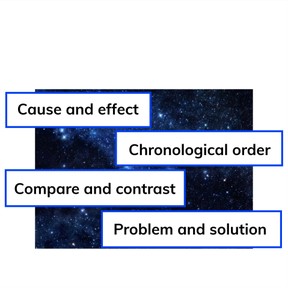



8,000 schools use Gynzy
92,000 teachers use Gynzy
1,600,000 students use Gynzy
General
In this lesson, students will learn about four types of non-fiction text structures: cause and effect, chronological order, compare and contrast, or problem and solution. They will read several passages and identify the text structures. At the end, they will write their own paragraph using one of the text structures.
Standards
CCSS.ELA-Literacy.RI.4.5
CCSS.ELA-Literacy.RI.5.5
Learning objective
Students will be able to identify non-fiction text structures.
Introduction
Students will make a list of transition words they can use in their writing. Introduce the text structures: cause and effect, chronological order, compare and contrast, and problem and solution. Students will name some non-fiction books they've read. The lesson will go over each text structure in more detail along with key words for each. Explain why it is important to recognize different text structures.
Instruction
Students will drag and drop the definition to the correct text structure. They will read sentences and determine whether each one would best fit in a cause and effect, chronological order, compare and contrast, or problem and solution. Students will read a passage about Neil Armstrong and John Glenn and identify the main text structure. They will also spin the wheel to write a sentence with one of the four types of text structures.
Quiz
Students will answer 10 true/false and multiple-choice questions.
Closing
Students will review what they learned:
- What are four text structure examples?
- What are key words to identify these structures?
- Why is this important?
Students will research a topic in US history and write a paragraph about it using one of the text structures.
The online teaching platform for interactive whiteboards and displays in schools
Save time building lessons
Manage the classroom more efficiently
Increase student engagement
Discover more!
About Gynzy
Gynzy is an online teaching platform for interactive whiteboards and displays in schools.
With a focus on elementary education, Gynzy’s Whiteboard, digital tools, and activities make it easy for teachers to save time building lessons, increase student engagement, and make classroom management more efficient.



